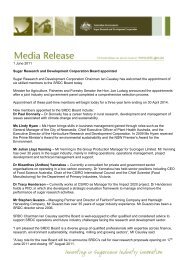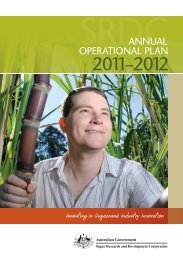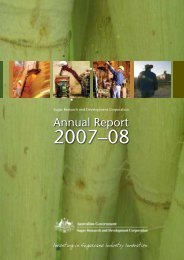Section 2 - Sugar Research and Development Corporation
Section 2 - Sugar Research and Development Corporation
Section 2 - Sugar Research and Development Corporation
Create successful ePaper yourself
Turn your PDF publications into a flip-book with our unique Google optimized e-Paper software.
1.12 Financial Assets<br />
The <strong>Corporation</strong> classifi es its fi nancial assets in the following categories:<br />
a) held-to-maturity investments; <strong>and</strong><br />
b) loans <strong>and</strong> receivables.<br />
<strong>Sugar</strong> <strong>Research</strong> <strong>and</strong> <strong>Development</strong> <strong>Corporation</strong><br />
NOTES OF THE FINANCIAL STATEMENTS<br />
The classifi cation depends on the nature <strong>and</strong> purpose of the fi nancial assets <strong>and</strong> is determined at the<br />
time of initial recognition. Financial assets are recognised <strong>and</strong> derecognised upon trade date.<br />
Effective Interest Method<br />
The effective interest method is a method of calculating the amortised cost of a fi nancial asset <strong>and</strong> of<br />
allocating interest income over the relevant period. The effective interest rate is the rate that exactly<br />
discounts estimated future cash receipts through the expected life of the fi nancial asset, or, where<br />
appropriate, a shorter period.<br />
Income is recognised on an effective interest rate basis except for fi nancial assets that are recognised<br />
at fair value through profi t or loss.<br />
Held-to-Maturity Investments<br />
Non-derivative fi nancial assets with fi xed or determinable payments <strong>and</strong> fi xed maturity dates that<br />
the group has the positive intent <strong>and</strong> ability to hold to maturity are classifi ed as held-to-maturity<br />
investments. Held-to-maturity investments are recorded at amortised cost using the effective interest<br />
method less impairment, with revenue recognised on an effective yield basis.<br />
Loans <strong>and</strong> Receivables<br />
Trade receivables, loans <strong>and</strong> other receivables that have fi xed or determinable payments that are not<br />
quoted in an active market are classifi ed as ‘loans <strong>and</strong> receivables’. Loans <strong>and</strong> receivables are measured<br />
at amortised cost using the effective interest method less impairment. Interest is recognised by applying<br />
the effective interest rate.<br />
Financial assets held at amortised cost – if there is objective evidence that an impairment loss has been<br />
incurred for loans <strong>and</strong> receivables or held to maturity investments held at amortised cost, the amount<br />
of the loss is measured as the difference between the asset’s carrying amount <strong>and</strong> the present value of<br />
estimated future cash fl ows discounted at the asset’s original effective interest rate. The carrying amount<br />
is reduced by way of an allowance account. The loss is recognised in the Statement of Comprehensive<br />
Income.<br />
1.13 Investments in Associates<br />
The <strong>Corporation</strong>s’s investment in its associates is accounted for using the equity method.<br />
Under the equity method, investments in the associates are carried in the entity’s balance sheet at cost<br />
as adjusted for post-acquisition changes in the entity’s share of net assets of the associates. Goodwill<br />
relating to an associate is included in the carrying amount of the investment. After the application<br />
of the equity method, the entity determines whether it is necessary to recognise any impairment loss<br />
with respect to the net investment in associates.<br />
SRDC Annual Report 2010–2011 85






